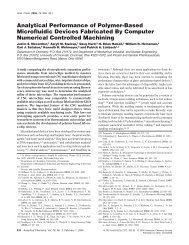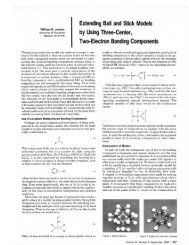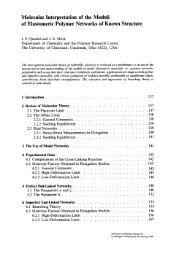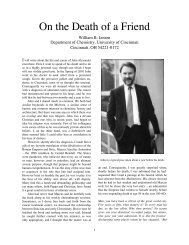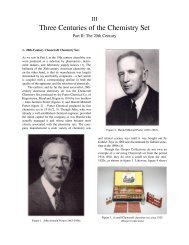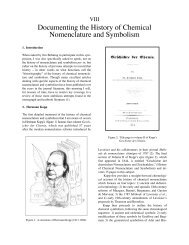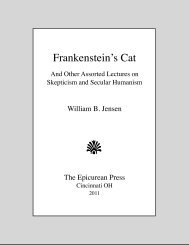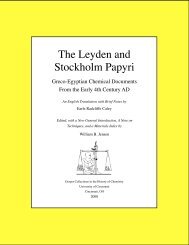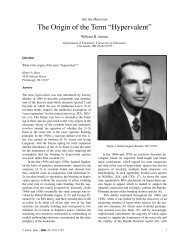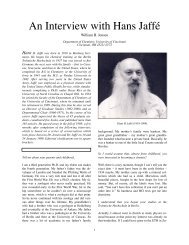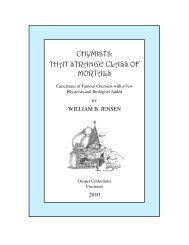101. KLM Shells.pdf - University of Cincinnati
101. KLM Shells.pdf - University of Cincinnati
101. KLM Shells.pdf - University of Cincinnati
Create successful ePaper yourself
Turn your PDF publications into a flip-book with our unique Google optimized e-Paper software.
Question<br />
Why do the labels for the electron orbits in the Bohr<br />
model begin with the letter K?<br />
Bartow Culp<br />
Department <strong>of</strong> Chemistry<br />
Purdue <strong>University</strong><br />
West Lafayette, IN 90032<br />
Answer<br />
The K, L, M-shell labels were not proposed by Bohr as<br />
part <strong>of</strong> his original 1913 quantum model <strong>of</strong> the atom<br />
but were rather the result <strong>of</strong> experimental studies <strong>of</strong> the<br />
phenomenon <strong>of</strong> X-ray fluorescence made by the British<br />
physicist, Charles Glover Barkla (figure 1), in the period<br />
1906-1911 (1). Barkla characterized the secondary<br />
radiations produced when samples <strong>of</strong> the elements<br />
were exposed to an X-ray beam in terms <strong>of</strong> both their<br />
homogeneity and penetrating ability (measured in<br />
terms <strong>of</strong> the number <strong>of</strong> sheets <strong>of</strong> aluminum metal required<br />
to absorb them). He found that these secondary<br />
X-rays fell into two classes, which he labeled K and L,<br />
based on the observation that the K radiation was more<br />
penetrating than the L radiation. He also observed that<br />
the production <strong>of</strong> K versus L radiation correlated with<br />
the atomic weights <strong>of</strong> the elements, with the elements<br />
Ca through Rh producing only K radiation, W through<br />
Bi producing only L radiation, and Ag through Ce producing<br />
a mixture <strong>of</strong> both. In 1913 these latter observations<br />
were refined by the British physicist, Henry<br />
Moseley (1887-1915), in his classic study <strong>of</strong> the relationship<br />
between the frequency <strong>of</strong> the secondary X-rays<br />
and the atomic numbers <strong>of</strong> the elements (2).<br />
Rationalization <strong>of</strong> the Barkla-Moseley X-ray fluorescence<br />
results in terms <strong>of</strong> the Bohr model is usually<br />
credited to a 1914 paper by the German physicist, Walther<br />
Kossel (1888-1956), who argued that the K radiation<br />
was due to an excited electron falling back into a<br />
vacancy in the first shell <strong>of</strong> an atom, and the L radiation<br />
to an excited electron falling back into a vacancy<br />
in the second shell (3, 4). As a consequence, the labels<br />
K and L became attached to the first and second shells<br />
Ask the Historian<br />
The <strong>KLM</strong> Shell Labels<br />
William B. Jensen<br />
Department <strong>of</strong> Chemistry, <strong>University</strong> <strong>of</strong> <strong>Cincinnati</strong><br />
<strong>Cincinnati</strong>, OH 45221-0172<br />
Figure 1. Charles Glover Barkla (1877-1944).<br />
<strong>of</strong> the Bohr atom, especially in the literature dealing<br />
with spectroscopy. Already in his 1911 paper, Barkla<br />
had speculated on the possible existence <strong>of</strong> even s<strong>of</strong>ter<br />
secondary X-rays beginning round Au and Pt and corresponding<br />
to possible M and N series, and these labels<br />
were soon attached to the third and fourth shells <strong>of</strong> the<br />
Bohr atom as well. Interestingly, Bohr himself seldom<br />
made use <strong>of</strong> these spectroscopic shell labels in his own<br />
writings, preferring instead to use numerical quantum<br />
numbers (5).<br />
So why did Barkla label his secondary X-ray series<br />
K and L? The answer appears in a footnote to his 1911<br />
paper (1):<br />
[These radiations were] previously denoted by the letters<br />
B and A ... The letters K and L are, however, preferable,<br />
as it is highly probable that series <strong>of</strong> radiations<br />
both more absorbable and more penetrating exist.<br />
J. Chem. Educ., 2003, 80, 996 1
In other words, though Barkla assigned arbitrary letters<br />
to his X-ray series, he started in the middle <strong>of</strong> the alphabet,<br />
rather than at the beginning, in order to allow<br />
for future expansion <strong>of</strong> his results in either direction.<br />
Given that M rather than K corresponds to the<br />
center <strong>of</strong> the alphabet, it has been suggested to the<br />
author that Barkla began instead at K and L because<br />
these two letters are found in his last name. Though a<br />
charming idea, I have found no documentary evidence<br />
to support this supposition.<br />
Literature Cited<br />
1. C. G. Barkla, “The Spectra <strong>of</strong> the Fluorescent Röntgen<br />
Radiations,” Phil. Mag, 1911, 22, 396-412. See especially<br />
the footnote, p. 406.<br />
2. H. Moseley, “The High Frequency Spectra <strong>of</strong> the<br />
Elements,” Phil. Mag., 1913, 26, 1025-1034 and Ibid., 1914,<br />
27, 703-713.<br />
3. W. Kossel, “Bemerkung zur Absorption homogener<br />
Röntgenstrahlen,” Verhand. deutschen physik. Gesell., 1914,<br />
16, 898-909.<br />
4. J. L. Heilbron, “The Kossel-Sommerfeld Theory and<br />
the Ring Atom,” Isis, 1967, 58, 451-485.<br />
5. L. Rosenfeld, Ed., Niels Bohr: Collected Works, 9<br />
Vols., North-Holland Publishing: Amsterdam, 1972-1996.<br />
WILLIAM B. JENSEN<br />
Do you have a question about the historical origins <strong>of</strong> a<br />
symbol, name, concept or experimental procedure<br />
used in your teaching? Address them to Dr. William B.<br />
Jensen, Oesper Collections in the History <strong>of</strong> Chemistry,<br />
Department <strong>of</strong> Chemistry, <strong>University</strong> <strong>of</strong> <strong>Cincinnati</strong>,<br />
<strong>Cincinnati</strong>, OH 45221-0172 or e-mail them to<br />
jensenwb@ucmail.uc.edu<br />
2010 Update<br />
I recently received an e-mail from a reader claiming<br />
that Bohr assigned K to the first shell because it is the<br />
11th letter <strong>of</strong> the alphabet - 11 being shorthand for one<br />
shell, one subshell. Likewise L, as the 12th letter <strong>of</strong> the<br />
alphabet, was shorthand for one shell, two subshells,<br />
etc. Though this is certainly a clever mnemonic device<br />
for students, it has, to the best <strong>of</strong> my knowledge no<br />
basis in the historical record and is essentially a numerical<br />
coincidence, which, like the story associating<br />
the letters with Barkla’s surname, is yet another example<br />
<strong>of</strong> an historical myth. Likewise, I have also encountered<br />
the suggestion that K and L were shorthand<br />
for the German words, kurz (short) and lange (long)<br />
and were a reference to the respective wavelengths <strong>of</strong><br />
the two kinds <strong>of</strong> secondary X-ray radiation.<br />
2 J. Chem. Educ., 2003, 80, 996
THE QUANTIFICATION OF ELECTRONEGAVITIY: PART II<br />
J. Chem. Educ., 2010, 87, xxx 3



